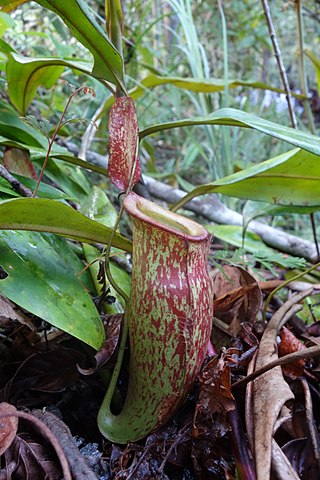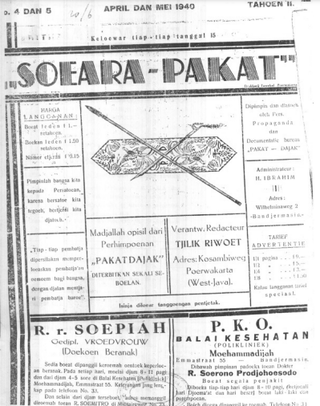Related Research Articles

The Dayak or Dyak or Dayuh are one of the native groups of Borneo. It is a loose term for over 200 riverine and hill-dwelling ethnic groups, located principally in the central and southern interior of Borneo, each with its own dialect, customs, laws, territory, and culture, although common distinguishing traits are readily identifiable. Dayak languages are categorised as part of the Austronesian languages. The Dayak were animist in belief; however, since the 19th century there has been mass conversion to Christianity as well as Islam due to the spreading of Abrahamic religions.

Central Kalimantan is a province of Indonesia. It is one of five provinces in Kalimantan, the Indonesian part of Borneo. Its provincial capital is Palangka Raya and in 2010 its population was over 2.2 million, while the 2015 Intermediate Census showed a rise to 2.49 million and the 2020 Census showed a total of 2.67 million; the official estimate as at mid 2021 was 2,702,200.

The dayak fruit bat or dyak fruit bat is a relatively rare frugivorous megabat species found only on the Sunda Shelf of southeast Asia, specifically the Malay Peninsula south of the Isthmus of Kra, and the islands of Borneo and Sumatra. There are three species in the genus Dyacopterus: D. spadiceus, D. brooksi and D. rickarti. All are found in the forests of Malaysia, Thailand, and the Philippines. Few specimens of any of the three species exist, due not only to their rarity, but also because they rarely enter the subcanopy of the forest where they can be caught in scientists' nets.

Nepenthes ephippiata, or the saddle-leaved pitcher-plant, is a tropical pitcher plant endemic to Borneo. It occurs in the Hose Mountains of central Sarawak, as well as Mount Raya and Bukit Lesung in Kalimantan. Non-climbing plants from the Hose Mountains appear to have less decurrent leaf attachment than specimens from Central Kalimantan, however the characteristic saddle after which the species is named is fully developed in climbing plants. Nepenthes ephippiata is closely related to N. lowii.

The Banjar or Banjarese are an indigenous ethnic group native to the Banjar regions in the southeastern Kalimantan hemisphere of Indonesia. Nowadays, Banjarese diaspora can be found in neighbouring Banjar regions as well; including Kotabaru Regency, the southeastern regions of Central Kalimantan, southernmost regions of East Kalimantan, and some provinces of Indonesia in general. The Banjarese diaspora community also can be found in neighbouring countries of Indonesia, such as Brunei, Malaysia, and Singapore.

Nepenthes × kuchingensis is a natural hybrid between N. ampullaria and N. mirabilis. Although it is named after the city of Kuching in Sarawak, this plant has a wide distribution across Borneo, New Guinea, Peninsular Malaysia, Sumatra, and Thailand.

The Kendayan are an Indonesian ethnic group native to Kalimantan, Indonesia in Borneo. The population of the group is around 366,000.
Ngaju is an Austronesian language spoken along the Kapuas, Kahayan, Katingan, and Mentaya Rivers in Central Kalimantan, Indonesia. It is closely related to the Bakumpai language. There are three dialects—Pulopetak, Ba'amang, and Mantangai.
The Ibanic languages are a branch of the Malayic languages indigenous to western Borneo. They are spoken by the Ibans and related groups in East Malaysia and the Indonesian province of West Kalimantan. Other Dayak languages, called Land Dayak, which are not Ibanic, are found in the northwest corner of Kalimantan, between Ibanic and non-Ibanic Malayic languages such as Kendayan and the Malay dialects of Sarawak and Pontianak.
The Kayanic or Kayan–Murik languages are a group of Austronesian languages spoken in Borneo by the Kayan, Morek Baram, Bahau, and related peoples.
The Barito languages are around twenty Austronesian languages of Indonesia (Borneo), Southern Philippines, plus Malagasy, the national language of Madagascar. They are named after the Barito River located in South Kalimantan, Indonesia.

The Ngaju people are an indigenous ethnic group of Borneo from the Dayak group. In a census from 2000, when they were first listed as a separate ethnic group, they made up 18.02% of the population of Central Kalimantan province. In an earlier census from 1930, the Ngaju people were included in the Dayak people count. They speak the Ngaju language.

Bakumpai or Baraki are indigenous people of Borneo and are considered as a sub-ethnic group of the Dayak Ngaju people group with Islamic background. The Bakumpai people first occupy along the Barito riverbanks in South Kalimantan and Central Kalimantan, from Marabahan to Puruk Cahu, Murung Raya Regency. The Bakumpai people first appeared as a newly recognized people group in census 2000 and were made up of 7.51% of Central Kalimantan population, which before this the Bakumpai people were considered as part of the Dayak people in a 1930 census.

West Kotawaringin Regency is one of the thirteen regencies which comprise the Central Kalimantan Province on the island of Kalimantan (Borneo), Indonesia. The population of West Kotawaringin Regency was 235,803 at the 2010 Census and 270,400 at the 2020 Census; the official estimate as at mid 2021 was 272,531. The town of Pangkalan Bun is the capital of West Kotawaringin Regency. The regency has an area of about 10,759 km2.

Anakletus Tjilik Riwut, more commonly referred to simply as Tjilik Riwut, was an Indonesian journalist, military officer, and politician, who served as the second Governor of Central Kalimantan from 1958 until 1967, as an Independent. He was also a major figure in the Indonesian National Revolution, becoming one of the leaders of the Kalimantan Physical Revolution in Dutch Borneo after the end of World War II, along with Idham Chalid, Hasan Basry, Mohammad Noor, and a number of other decentralized leaders.

Bubur pedas is a traditional porridge dish for the Malays both in Sambas, West Kalimantan (Indonesia) and Sarawak (Malaysia). It is usually served during Ramadan after the Muslim ending their fast on the iftar time.

Bahau people is a sub-ethnic group of the Dayak people who inhabit West Kutai Regency (9.3%), East Kalimantan, Indonesia.

Kotawaringin, or Kota Waringin was a sultanate on the south coast of Borneo. It covered an area in what is now the Indonesian province of Central Kalimantan. Its final form was a brief existence as an autonomous "native state" in the United States of Indonesia between 1949 and 1950.

Dayak in politics refers to the participation of Dayaks to represent their political ideas and interests outside of their community. The movement has continued to have a profound impact on the development of Indonesia and Malaysia, especially in Kalimantan and Sarawak.
References
- ↑ Rianti, Yuni. 2009. Pemetaan pemakaian kata sapaan dalam Bahasa Mendawai dan Kota Waringin di masyarakat Pangkalan Bun, Kalimantan Tengah . Malang: Universitas Muhammadiyah Malang.
- ↑ White, Chad (2008). Genetic inheritance in the Malayic languages of Kotawaringin Barat, Indonesia (M.A. thesis). Athens: University of Georgia.
- ↑ Wood, Lalani (2000). "Language variation in Kotawaringin Barat and its implications for community development: A survey report". In Michael Leigh (ed.). Borneo 2000: Sixth Biennial Meeting of the Borneo Research Council. Kota Samarahan: Universiti Malaysia Sarawak : Sarawak Development Institute.